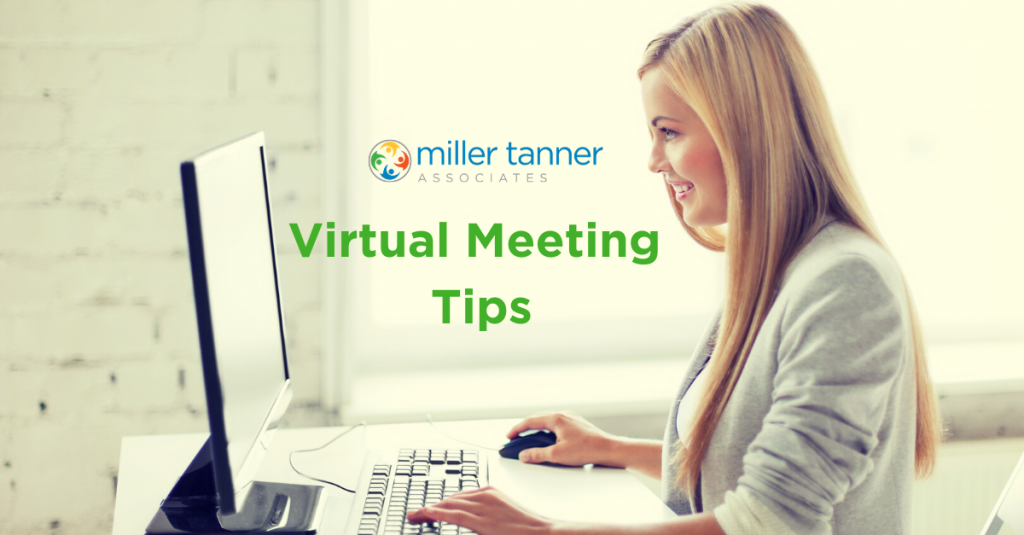
Virtual Meeting Tips for Success
To ensure that your next virtual meeting is a successful one, the Virtual Events Team at Miller Tanner has compiled some useful best practices.
When planning the virtual meeting:
- Be time-efficient. Streamline your meeting by compressing your agenda to fit within a 4-hour or less timeframe.
- It’s preferred to use video conferencing but also provide an audio dial-in option as a back up for anyone that might have internet challenges.
- Have a backup plan in case of audio/video connection issues or other technical difficulties that might arise.
When you are the presenter:
- Have the right equipment. To avoid the common pitfalls of virtual meetings related to audio and visuals, have the right equipment and network connection, such as a high-definition webcam, hard-wired internet connection, external microphone, lighting, or quality headset, and most importantly, know how to work this technology properly. Do not use cell or speakerphones because this can muffle your voice and pick up distracting background noises.
- Dress for success. Be mindful that what you choose your wear might interfere with your microphone (scarf, large earrings, etc.). Also, consider your color of clothing. For example, if you are using a green screen, avoid green and/or patterned clothing. Stick with basic solid colors.
- Practice and practice again. Rehearse so that you are well prepared to deliver your presentation. When you present live, have a glass of water nearby as well as your notes to use as a reference if needed.
- Don’t forget to run through a technical rehearsal. Understand the technology and how it works. Prior to your event, rehearse slide navigation and all the features that allow you to engage with your audience. Understand the tools such as how to advance slides, manage chats, and push out pollings.
- Review housekeeping information with attendees prior to the virtual meeting presentations to ensure that your attendees are comfortable submitting or asking questions and understand where to access all support documents.
- Make your presentation engaging – this is key to a successful virtual experience. Virtual meetings should include a lot of discussions. Pose questions regularly to encourage chat and make it a priority to interact with participants throughout all your event sessions. Engage your audience with the virtual event platform features. Ask your audience questions in a wide variety of formats, such as multiple-choice, rating, text responses, polling, voting, breakout sessions, and even fun game challenges. With these methods of engagement, your audience will be more inclined to participate and interact with the presentation.
- Screen share so that your attendees can follow along. Keep your presentations concise and on point.
When you are an attendee:
- Test the technology ahead of time so that you aren’t joining your meeting late.
- Use the chat window to ask questions and engage with the presenter.
- Turn off any distractions and close any unnecessary screens.
When on camera (presenter and/or attendee):
- Check your lighting. Natural lighting is best with windows facing you to illuminate your face.
- Give eye contact to your camera and look into it when speaking. Your camera should be placed at eye level.
- Frame yourself in the camera view so that your head and top of your shoulders are prominent in the screen. Adjust your camera or your chair if you are too close or too far from the screen.
- Be aware of your background. Less is more. Make sure your background is simple and uncluttered. You can use a green screen image to replace a messy background.
- Minimize distractions. Close any open screens that might distract your attention from the virtual meeting. Remember you are on camera, so you always want to give your full attention to the speaker.
- Raise your voice one notch higher so that you can be heard clearly through the external or internal microphone. This helps you feel more confident while speaking and helps keep a slower pace.
- Mute your microphone when you are not speaking. And unmute only when you speak. This allows for there to be no noise distractions during presentations.
- If you need to step away from your desk for a moment or eat, etc., make sure that you turn off your camera and, of course, mute your microphone.
Implementing these tips and best practices into your next virtual meeting can greatly improve its effectiveness and enhance the overall experience for you as a speaker or as an attendee. Miller Tanner Associates can help assist you through these virtual meeting best practices and more to ensure an exceptional meeting from start to finish.

